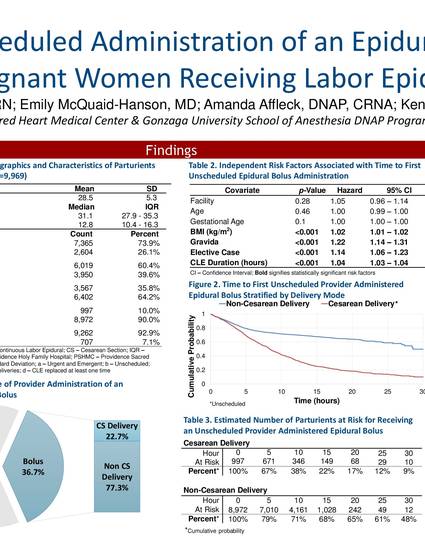
- School of Anesthesia
Background The labor and delivery process is a painful experience that pregnant women undergo and while various medical options are available for managing labor pain, labor epidurals are the most common.1,3 Breakthrough pain, or inadequate analgesia, is a significant complication of labor epidurals that is typically managed with the administration of an unscheduled epidural bolus. The purpose of this evidence-based practice (EBP) project is to describe the rate of unscheduled epidural bolus administration in pregnant women receiving continuous labor epidurals (CLE) at Providence Sacred Heart Medical Center (PSHMC) and Providence Holy Family Hospital (PHFH).
Methods • Design: Retrospective, observational, EBP project • Human subjects protection: De-identified data was extracted into a HIPPA compliant REDCap database after facility approval and IRB exemption • Inclusion Criteria: Parturient women age ≥18 with labor epidurals at PSHMC and PHFH from January 2015 to December 2019 (Table 1) • Outcome Measurement: Unscheduled provider administered epidural bolus after epidural initialization (Figure 1) • Bivariate: T-tests (symmetrical continuous data), Mann Whitney U (skewed continuous data), Chi-Test (categorical data) • Multivariate: Kaplan Meier analysis performed on epidural bolus timing (Figure 2) • Multivariate multivariable: Proportional hazards model was used to identify independent risk factors associated with time to first unscheduled provider administered epidural bolus (Table 2)
Discussion We found that approximately 36.7% of parturient women with a CLE required at least one unscheduled provider administered epidural bolus. Gravida 1, elective case type, increased BMI and CLE duration were identified as independent risk factors associated with receiving a provider bolus. Of the identified risk factors, gravida 1 was the most significant with women having a 1.22 increase in risk of requiring an unscheduled provider administered epidural bolus (hazard risk 1.22; 95% CI 1.14 – 1.31; p <0.001). The rate of 36.7% is higher compared to literature reported rates of 30.7% and 14.4% from RCTs and observational studies that had comparable epidural regimens and techniques to our facilities. 2,4,5 Further in-depth investigation is warranted in describing with more detail the patient characteristics and anesthesia provider practices as they relate to unscheduled epidural bolus administration.
Available at: http://works.bepress.com/kenn-daratha/39/
